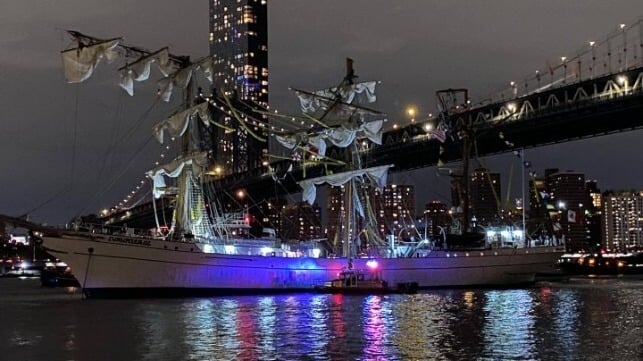Two Killed as Mexican Sail Training Ship Hits Brooklyn Bridge

During a maneuver in New York harbor, the Mexican sail training vessel Cuauhtémoc struck the historic Brooklyn Bridge while onlookers watched in horror. The Mexican Navy is reporting that 19 cadets were injured and two others died from their injuries.
Mexican media outlets have identified the deceased as Adal Jair Marcos, a resident of Oaxaca, and América Yamileth Sánchez, originally from Veracruz.
Reports are saying there were a total of 229 sailors aboard the vessel, with the Navy reporting that 11 are in more serious condition and nine are in stable condition. She was in New York City on a goodwill stop during a training cruise bound for Iceland. The training cruise is being terminated, and the Mexican embassy is making arrangements to reunite the cadets with their families.
The vessel was departing its dock and making a ceremonial outbound transit on the East River, with the cadets high up in the rigging. It pulled away from its berth, moving astern with a tug assist in preparation to head southwest, downriver and into New York Harbor. As it prepared to turn onto a southwesterly course and head downriver, the training ship kept moving astern under power - heading upriver, opposite its intended direction of travel. The twin-screw assist tug was not connected with a towing hawser, and was not able to intervene before the allision.
The East River has strong currents, and the tide was coming in - towards the bridge - at the time of the casualty. The wind was also northeasterly, towards the bridge, according to initial accounts. By the time Cuauhtémoc made contact with the underside of the bridge deck, she was making about six knots astern.
A Mexican Navy training ship crashed into Brooklyn Bridge in New York, good job guys
— Enguerrand VII de Coucy (@ingelramdecoucy) May 18, 2025
pic.twitter.com/nyqf413fch
All three of the ship's masts hit the underside of the bridge, and spectators who had gathered to watch the transit reported hearing the sounds of breaking wood.
Bystander photos showed multiple cadets dangling from the masts in their protective harnesses after impact, necessitating a complex rescue response. The Mexican Navy reports that no one fell into the river.
The vessel’s masts are 158 feet in height, but the bridge has a clearance of 135 feet. NYC Mayor Eric Adams reported that the bridge did not sustain damag, and it has already reopened to traffic.
The Cuauhtémoc is now moored at Pier 36 on the East River, and damage assessments and salvage plans are under way. Coast Guard Sector New York has established a 50-yard safety zone around the vessel, and has asked passing traffic to transit at slow speed. The New York City Police Department's marine units are patrolling the safety zone.
The 300-foot Cuauhtémoc was commissioned in 1982 as a modern replica of the famous sail training ships built in the 1930s. She is one of four sister ships, along with Colombia's Gloria, Ecuador's Guayas and Venezuela's Simón Bolívar.
While detailed specifics of Cuauhtémoc's propulsion system are not readily available, her sister ships are fitted with a controllable pitch propeller (CPP) system and a single auxiliary engine. A CPP system uses mechanical or hydraulic means to rotate the angle (pitch) of the propeller blades to move ahead (positive pitch) or astern (negative pitch). By changing the blade pitch, either direction of thrust - or no thrust at all - can be produced while the engine remains in the same direction of rotation.
While the cause of the Cuauhtémoc's allision with the bridge is not yet known, at least four previous vessel casualties were caused by a CPP system breakdown that resulted in sudden, uncontrolled full-astern thrust - most recently the 2008 sinking of the Alaska Ranger.
The National Transportation Safety Board has deployed a rapid-response team of investigators, who will be examining all potential human and mechanical factors closely, including Cuauhtémoc's propulsion system.
